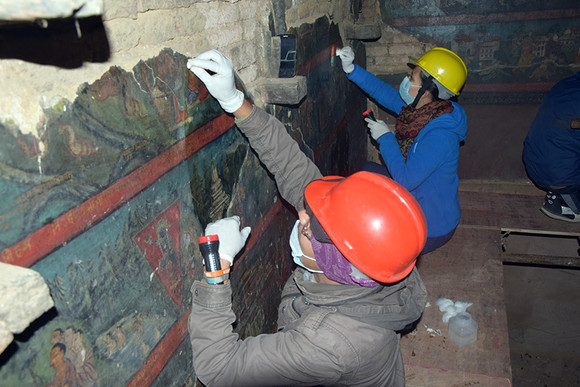Fall and Rise of Shantipur Mural Paintings: Conservation team salvages cultural treasure
19.05.2016Shantipur Temple’s fate changed overnight when the 2015 earthquake hit. The disaster left the temple and its mural paintings in a dire state – but not for long. Local communities wanted Shantipur to be rebuilt rapidly to restore its status as one of the most significant places of worship among Kathmandu devotees.
The brick and mud structure located in the Swayambhu Monument Zone of the Kathmandu Valley World Heritage Site is an important Newari Buddhist shrine. The quake severely damaged several walls, including the northern wall and vestibule where large-scale mural depictions of Buddhist deities are located.
National and international experts have worked together to safeguard the mural paintings. Thousands of painting fragments were salvaged from piles of debris and taken to the National Museum in Chaauni. After careful structural assessment, the Department of Archaeology, UNESCO and the Federation of Swayambhu Management and Conservation found that the extent of the damage and highly vulnerable wall conditions implied that in-situ preservation was not possible. The detachment of the mural paintings was deemed necessary to save what was left.
Why is Shantipur such an artistic icon in Nepal? Here’s where history, memory and myth collide.
The inscription, dating from 1658, commemorates King Pratap Malla’s incursion into the shrine during a time of drought to pacify the serpent deities and bring rain. The shrine consists of two precincts: the secret inner chamber – where the esoteric deity Cakrasamvara is worshiped; the vestibule, where an elaborate mural painting of the Buddhist text, Svayambhūpurāna, is depicted. This scripture is one of the most important Newari Buddhist texts describing the origin of the Kathmandu Valley. Although the recent painting only dates back to 1904, during the time of its renovation, evidence emerged that the painting already existed during the time of King Pratap Malla. The depiction of Svayambhūpurāna is historically important, not only due to its rarity but also because of its connection to the foundation of the city of Kathmandu.

The rescue mission of the temple’s mural paintings was led by international conservation specialist Rodolfo Luján-Lunsford. They used the Stacco technique – or detachment of the mud-plaster and painting with render alone – to remove the wall painting from the structure of which it was a part. A total of 31 fragments of different sizes from the south, east and west walls have been carefully detached, properly treated, documented, and moved to the National Museum.
“This is indeed a great contribution for the sake of keeping the memory of humanity’s origins and culture,” Luján explained.
Now a team of Nepali conservators is working for further treatment of the recovered fragments. The team consists of staff members from the Department of Archaeology, its Central Conservation Laboratory for Cultural Heritage, the National Museum, the Hanumandhoka Palace Museum and the National Art Gallery in Bhaktapur.
The rescue work was carried out in the framework of a conservation workshop/training exercise that allowed participants to enhance their expertise through theoretical sessions, laboratory exercises and practical application. They also gained knowledge of in-situ conservation treatment, including cleaning blackened murals at Vasupura Temple, which is located southeast of the Swayambhu Stupa. The initiative was carried out by the Department of Archaeology and UNESCO in collaboration with the ICOMOS Nepal, with funding support from the Fok Ying Tung Foundation Funds-in-Trust.
“Once the precious fragments get fully reintegrated and recomposed as depicted on the original walls of Shantipur, we will decide how to best display them,” said Department of Archaeology Director-General Bhesh Narayan Dahal.
UNESCO Kathmandu’s Culture Unit believes this initiative represents a great collaborative effort between national and international experts and that the unique experience gained over the months will enhance Nepal’s capacity in restoring wall paintings; an important aspect of the country’s heritage.
For more, please contact Nipuna Shrestha, UNESCO Kathmandu Culture Unit, Email: s.nipuna@unesco.org

